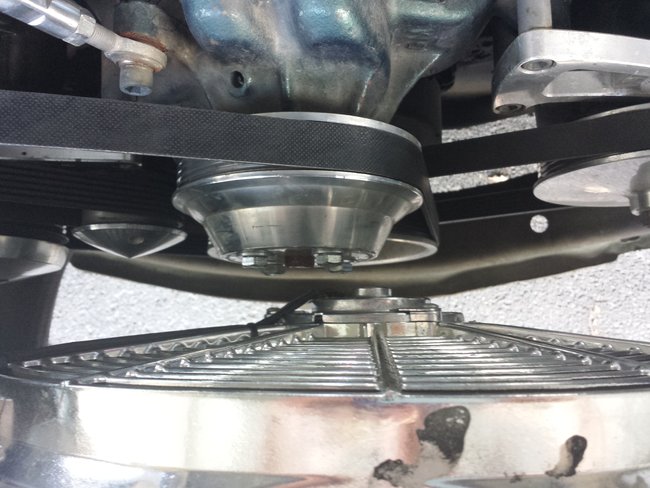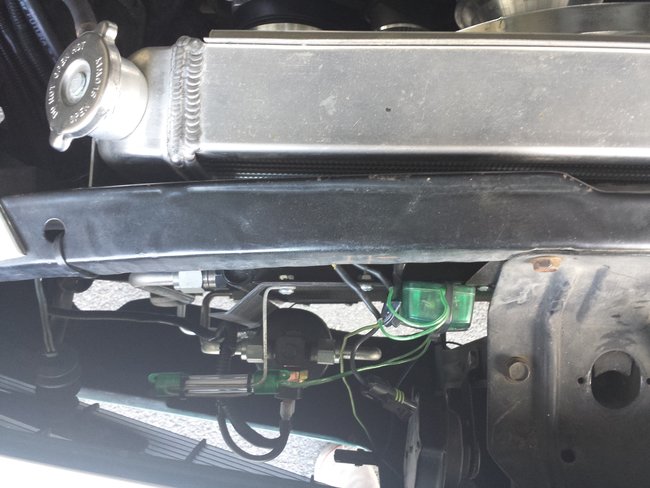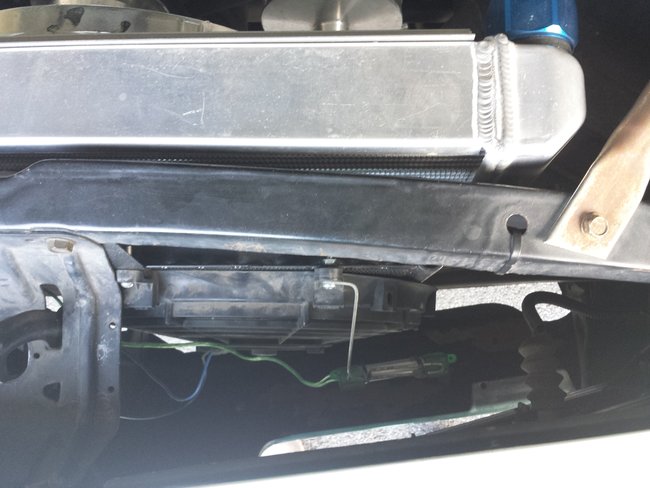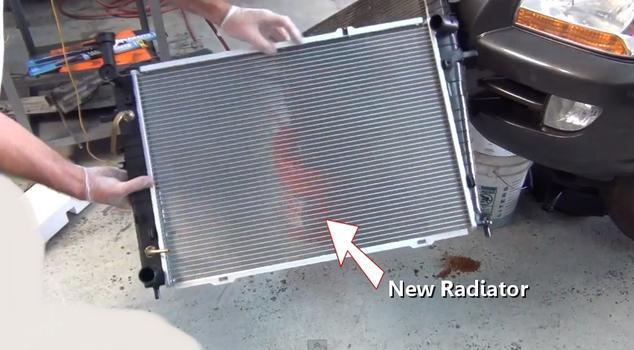Then about 2 years ago the radiator started leaking. I replaced it with a 2-row aluminum with an electric fan which to me made sense because that electric fan was going to keep running fast while the car was sitting at lights and therefore would keep the car even cooler and that was their promise.
Well, the radiator didn't fit so back it went and I was looking around for a radiator that had more of a 45-degree angle where the filler neck was. There only appear to be 2 radiators available for the classic muscle car. You either get a really boxy looking one or you get a more curvy one that has a 45-degree neck and everyone just brands the radiators as their own.
No one seemed to know what to tell me regarding 2-row or 3-row or 4-row. I did my research as best I could with what was available on classic car replacements. The only thing I could find was that the 2-row's did a better job of cooling than the 4 rows which didn't make a whole lot of sense to me but it seemed to be the same pitch regardless of who I talked to. Come to find out now that the reason that the 3 or 4-row radiators don't cool any better and maybe even a bit worse was that they weren't increasing the size of the radiator they were just adding rows into the existing one size fits all radiators. You can't get a 1.25" row in anything but a 2-row radiator because if you go to a 3-row they just make the rows narrower and they take up a little more space for the extra row and ultimately have less room to store coolant. But to have the public believe that it was somehow unique to aluminum seems to me to be a scam.
My problem was that the 2-row was causing my car to overheat and yet everyone I talked to ensured me that the 2-row was my best bet. There were a few unscrupulous people that tried to sell me a new radiator with more rows which was actually when I realized that the supposedly bigger radiators weren't any bigger.
I went through everything. I flushed the radiator because I found out that when they installed it no-one flushed the system, a brand new radiator and no one flushed out the Stop Leak that was put in other than inserting a hose into the block. I don't know what happened to my mechanic's brain but he won't even talk to me anymore. I guess he's feeling bad just not bad enough to apologize so this is pushing all this work onto me except I have serious chronic pain problems and I can't always do the work. There was a lot of Stop Leak in the coolant it took 2 flushes to get most of it out and as of last week, I saw some small deposits collecting again.
Anyway, I've still not found a culprit for why I'm having overheating problems I bought the radiator and fan as a package deal and the so-called experts that I've talked to all seem to think that I have plenty of CFM although must of my research suggests a fan in the 3000 CFM range and I'm at 2600 but they tell me that is more than most people have. Hmm? What the heck is going on?
Then I came across a person's website were he was customizing a cooling system for his Jeep and he was explaining the actual principles he used in his process. It was the first time the sun shined. He was talking about the "area" of the radiator which got me thinking about cubic inches or volume. The first thing I realized was the 16" fan that I was sold was only big enough to cool less than 50% of the actual area which I never questioned because that's how most of these aluminum radiators and electric fans are sold. I don't know if the combination is even a good combination that should assure a cool engine because they sell the same radiator pretty much just changing the core size and slapping on a single fan or 2 fans and because most of the cars are probably smaller 350's or even less it works. I'm unfortunately not one of those people that it comes together for, however. If you added the depth of course it becomes even worse. Instead of having a big belt-driven fan here was this 16" fan that was tight against the back of the radiator with an even tighter shroud that wouldn't allow any extra air in around the sides. That got me thinking on how to increase my fan coverage of the radiator without having to go back to the noisy mechanical fan which was always so loud and annoying.
The problem is that the actual radiator support only has an area of 23" X 17" which prevents getting any type of a combination fan that would cool more area. This is when I discovered that 2 - 10" fans only cover 50% of the area that 1 - 20" fan does. I know it seems crazy but it makes no difference what size fan you are using it always takes 4 smaller fans to cover as much area as a single fan 2 times bigger than the size of one little fan.
It would take 4 - 10" fans to cover the same area as 1 - 20" fan. It drove me nuts for an entire day and I'm still not sure that it makes any sense to me but I verified the equation on other sites to ensure that it wasn't an error on the site I was using. That makes this problem incredibly difficult to resolve were 1 - 16" fan-only covers 200 square inches but my radiator is 396 square inches. Again that doesn't cover depth which would bring it to 978 cubic inches or a little less than 25% of the volume. That seems terrible to me.
The radiator opening is the same size as it was back when the cars were originally built of course they only had a 396 cubic inch engine then I've got a 454. They also used the mechanical fan which is the only thing I don't want. I spent my day doing calculations trying to figure what would be the best setup within my existing radiator. Unfortunately, that would be to 11" fans maybe an 11.5" depending but that doesn't do any better than the 16" fan I already have. 2 -11" fans cover an area of 189 square inches technically a few inches less than my 16" fan.
If I am willing to get a custom shroud built I could get 2 - 14" fans in but they would slightly exceed the size of the core and they would have to be cut out around the input and output hoses and attached using the same holes as the radiator itself. 2 - 14" fans would bring my area up to 308 still less than my actual radiator but 110+ more surface area excluding the hangover onto the radiator support on the sides. I also might be able to create a setup where the shroud would tilt the fans towards the side of the engine where the exhaust exits and probably the hottest part of the engine. That actually makes some sense and it might fit or it might not there's not a lot of room between the radiator and the engine which of course has the long water pump. Why exactly did they have a long water pump, to begin with? What was the thinking?
Today I went out and looked it over again and thought I might be able to get 2 - 14" fans between the condenser and the front of the radiator and just get rid of the shroud which I think is probably causing less air to flow since it's tight against the radiator and tight against the fan. In my mind that creates a 16" tunnel in the center of the radiator that gets cooled. I can't see that the fan would pull anything but the area directly in front of it the shroud is just a restriction on airflow unless like I said you would tilt or move the fan away from the radiator and more toward the engine then you might get some extra flow.
I saw some 14" fans that are high output pushing some 4000 CFM which is impressive of course I might have some power problems trying to run them. But a marginal change is not going to get me a running car when it's all but 100 degrees outside and I've turned on the A/C which I haven't even been able to do. The few times I've had it out when it was really hot I had to have the heat on high.
Right now I can run the car for short periods when the temperature is in the low 70's but once it gets into the upper 70's I may get stuck somewhere if I get caught up in a traffic snarl.
The other option would be to have someone make custom radiator support that would allow me to have a wider radiator then I could get like a Chevrolet C10 radiator or even a Chevelle radiator that would give me some more choices. I wonder if I could get a Chevelle radiator support into my Camaro?
Another option would be to get a 10" fan in the upper left corner where the heated coolant enters the radiator. Maybe it would get enough heat out.
Anyway, I'm getting paralysis by analysis and not being a professionally trained mechanic I can get stuck on some of the details that maybe aren't so crucial. What are your thoughts?
Sunday, October 20th, 2019 AT 3:49 PM





